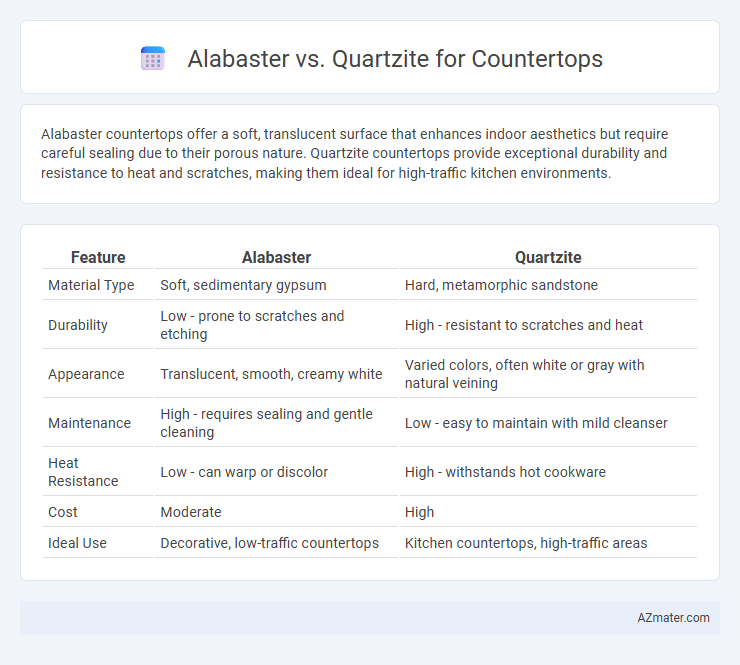Alabaster countertops offer a soft, translucent surface that enhances indoor aesthetics but require careful sealing due to their porous nature. Quartzite countertops provide exceptional durability and resistance to heat and scratches, making them ideal for high-traffic kitchen environments.
Table of Comparison
| Feature | Alabaster | Quartzite |
|---|---|---|
| Material Type | Soft, sedimentary gypsum | Hard, metamorphic sandstone |
| Durability | Low - prone to scratches and etching | High - resistant to scratches and heat |
| Appearance | Translucent, smooth, creamy white | Varied colors, often white or gray with natural veining |
| Maintenance | High - requires sealing and gentle cleaning | Low - easy to maintain with mild cleanser |
| Heat Resistance | Low - can warp or discolor | High - withstands hot cookware |
| Cost | Moderate | High |
| Ideal Use | Decorative, low-traffic countertops | Kitchen countertops, high-traffic areas |
Introduction to Alabaster and Quartzite Countertops
Alabaster countertops offer a translucent, soft texture characterized by their warm, creamy appearance, making them ideal for decorative, low-traffic surfaces due to their relative softness and susceptibility to scratching. Quartzite countertops provide a highly durable, natural stone option with a granular, crystalline structure formed from sandstone and quartz, known for exceptional hardness and resistance to heat and scratches. Selecting between alabaster and quartzite countertops depends on balancing aesthetic preferences featuring alabaster's luminous elegance against quartzite's robust functionality for high-use kitchen environments.
Understanding the Composition of Alabaster
Alabaster is a soft, translucent sedimentary rock primarily composed of gypsum (calcium sulfate dihydrate) or sometimes calcite (calcium carbonate), making it significantly softer and more porous than quartzite, which consists mainly of quartz crystals bonded under heat and pressure. This softness allows alabaster to be easily carved and sculpted but also makes it less durable and more susceptible to scratches, stains, and water damage compared to the much harder, dense, and heat-resistant quartzite ideal for high-traffic countertops. Understanding alabaster's composition is crucial for recognizing its decorative appeal and maintenance challenges in countertop applications.
What Makes Quartzite Unique?
Quartzite stands out for its exceptional hardness and durability, ranking between 7 and 8 on the Mohs scale, making it highly resistant to scratches and heat--ideal for kitchen countertops. Unlike alabaster, quartzite forms from sandstone subjected to intense heat and pressure, resulting in a dense, non-porous surface that resists staining and etching. Its natural quartz crystals create a sparkling, marble-like appearance, combining both aesthetic appeal and functional strength.
Aesthetic Differences: Alabaster vs Quartzite
Alabaster countertops exhibit a translucent, soft appearance with creamy white and subtle veining that adds an elegant, ethereal quality to interiors. Quartzite offers a more robust and dramatic aesthetic, featuring natural swirling patterns and bolder color variations, often resembling marble but with enhanced durability. While alabaster emphasizes light and delicacy, quartzite provides a striking, textured look ideal for statement countertops.
Durability Comparison: Scratch and Impact Resistance
Quartzite outperforms alabaster in durability, especially in scratch and impact resistance, making it a superior choice for countertops subjected to heavy use. Alabaster, being a softer and more porous mineral, is prone to scratches and damage from impacts, requiring careful maintenance. Quartzite's natural hardness, often close to that of diamonds on the Mohs scale, ensures excellent resistance to everyday wear and tear, preserving its surface integrity over time.
Porosity and Stain Resistance
Alabaster is highly porous and soft, making it more susceptible to stains and requiring regular sealing for countertop use. Quartzite is a dense, natural stone with low porosity, offering superior stain resistance and durability compared to alabaster. Choosing quartzite results in a more practical and long-lasting countertop surface, especially in high-traffic kitchen areas.
Maintenance Requirements for Each Material
Alabaster countertops require delicate maintenance due to their softness and porosity, making them prone to scratching and staining without proper sealing and gentle cleaning products. Quartzite countertops offer superior durability and low maintenance, resisting heat, scratches, and acids with only periodic sealing necessary to preserve their natural sheen. Homeowners seeking a hassle-free countertop solution typically prefer quartzite for its robust and stain-resistant properties compared to the more fragile alabaster.
Cost Analysis: Alabaster vs Quartzite
Alabaster countertops typically cost between $50 and $120 per square foot, making them a more affordable option compared to quartzite, which ranges from $90 to $200 per square foot. Quartzite offers superior hardness and stain resistance, justifying its higher price point for kitchens and high-traffic areas. Maintenance costs for alabaster can increase due to its softness and porosity, while quartzite requires less upkeep, impacting long-term expenses.
Suitability for Different Kitchen Designs
Alabaster countertops offer a soft, translucent appearance ideal for classic or Mediterranean kitchen designs, enhancing elegance with their creamy, warm tones. Quartzite suits modern and industrial kitchens better due to its durability and variety of patterns resembling marble or granite, providing both strength and aesthetic appeal. Choosing between Alabaster and Quartzite depends on balancing visual style preferences with functional requirements for kitchen counter surfaces.
Pros and Cons Summary: Which Is Best for Your Countertop?
Alabaster offers a soft, translucent beauty perfect for low-traffic countertops but lacks durability and is prone to scratching and staining. Quartzite provides exceptional hardness, heat resistance, and minimal maintenance, making it ideal for busy kitchen environments. For a balance of elegance and functionality, quartzite generally outperforms alabaster in longevity and practicality for countertops.

Infographic: Alabaster vs Quartzite for Countertop
 azmater.com
azmater.com